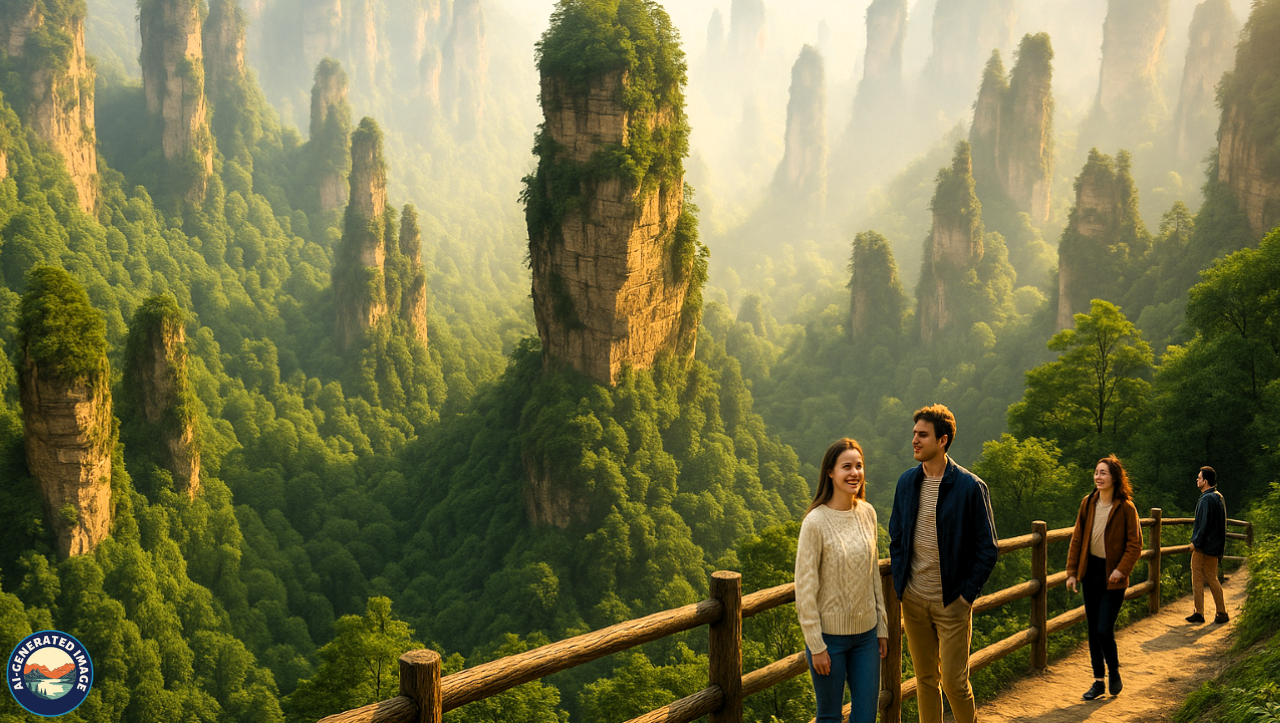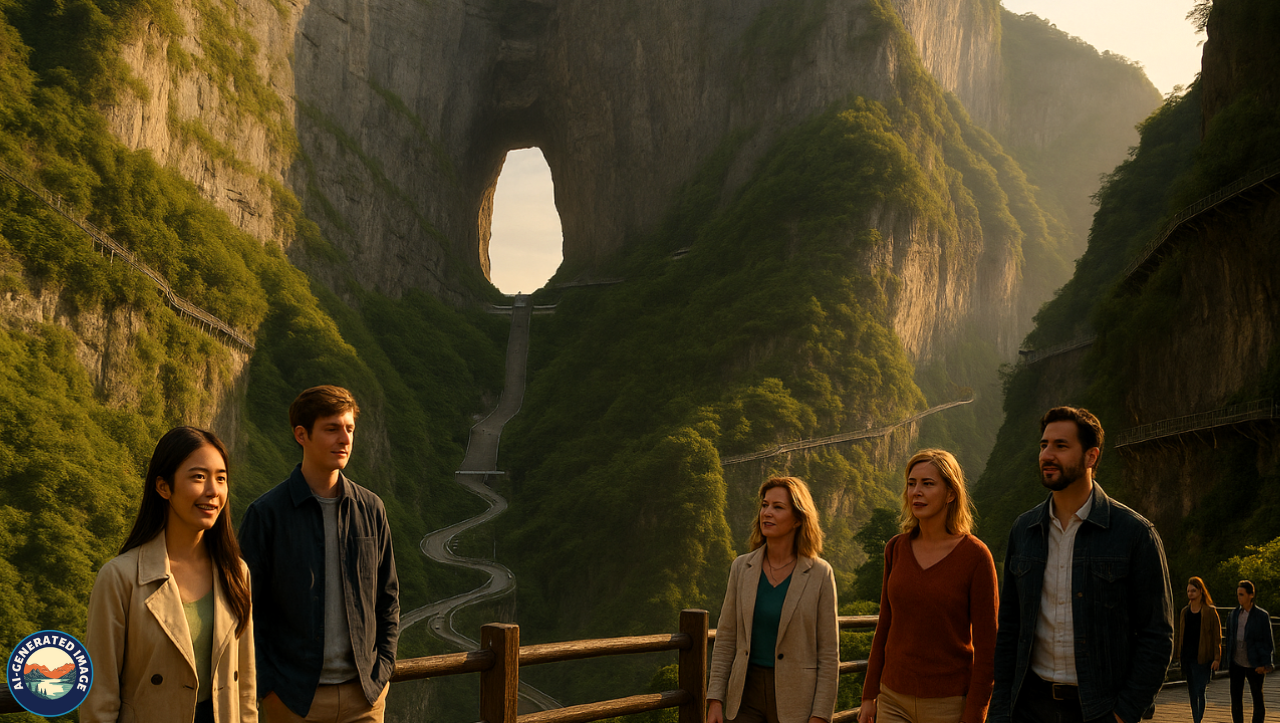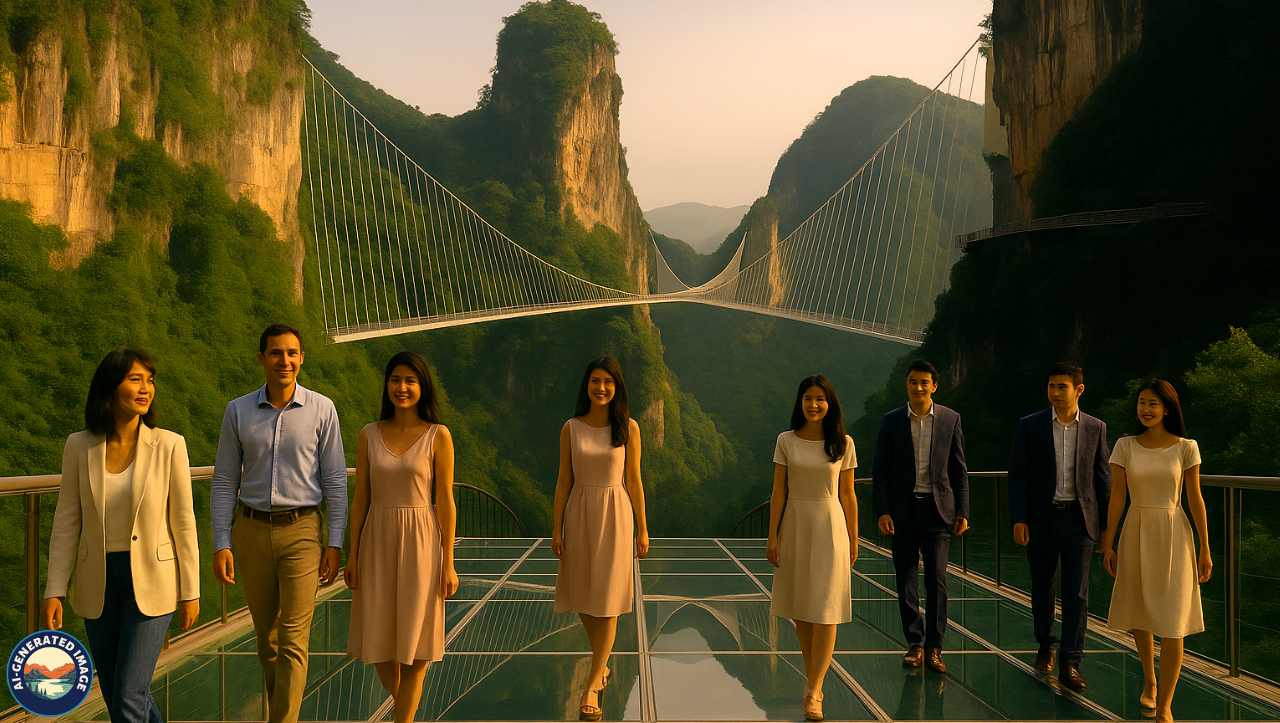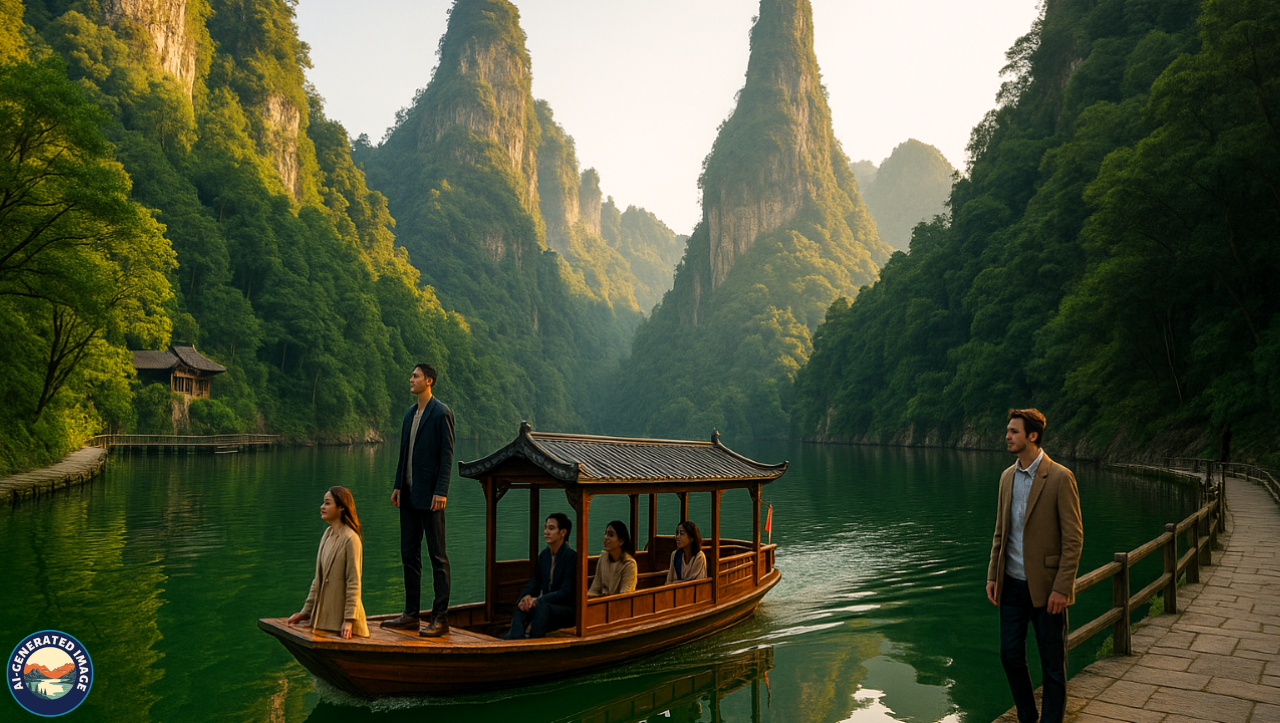Introduction
Zhangjiajie, nestled in the heart of China’s Hunan Province, is a landscape like no other—a realm where towering sandstone pillars soar into the sky, mist swirls mysteriously through lush forests, and the scenery feels as if it belongs in a dream. Once a hidden gem, this natural wonder rose to international fame when its surreal peaks inspired the floating Hallelujah Mountains in James Cameron’s Avatar.
Yet Zhangjiajie’s appeal goes far beyond Hollywood fame. With awe-inspiring national parks, a sky-high glass bridge, sacred caves, serene lakes, and a rich cultural heritage, this destination is a true marvel of nature and tradition. Whether you’re a nature enthusiast, adventurer, photographer, or cultural traveler, Zhangjiajie promises an exhilarating and unforgettable experience.
Geography and Geology
What makes Zhangjiajie visually distinct is its spectacular forest of quartz-sandstone pillars—thousands of vertical towers shaped by millions of years of erosion, tectonic activity, and weathering. These formations rise sharply from the forest floor, reaching up to 300 meters, often topped with small trees that cling to the rock.
This geological phenomenon is unique to the Wulingyuan Scenic Area, a UNESCO World Heritage Site covering more than 260 square kilometers. Unlike the rounded karst hills of Guilin, Zhangjiajie’s formations are spiky and slender, shaped primarily by physical erosion rather than chemical weathering. Morning mists frequently drape the landscape, creating an ethereal atmosphere that enhances the park’s magical appearance.
Top Attractions
Zhangjiajie National Forest Park

Established in 1982, this was China’s first national forest park and is the centerpiece of the Wulingyuan Scenic Area. Known for its dense concentration of towering pillars, the park is divided into several popular zones:
-
Yuanjiajie:
-
Home to the famed Avatar Hallelujah Mountain and the vertigo-inducing Bailong Elevator—a massive glass lift that climbs 326 meters up a cliff face.
-
Tianzi Mountain:
-
Renowned for panoramic views and a sea of clouds, it’s accessible via cable car and offers stunning photo opportunities.
-
Golden Whip Stream:
-
A picturesque trail flanked by cliffs and crystal-clear water, perfect for a tranquil nature walk.
The park is massive, with shuttle buses and cable cars connecting its zones. Visitors are advised to dedicate at least two to three days to explore it thoroughly.
Avatar Hallelujah Mountain
Previously known as the Southern Sky Column, this peak was renamed in honor of its cinematic twin in Avatar. It rises over 1,000 meters and appears to float in the mist, just like the mountains in the film. Visitors can reach it via the Bailong Elevator or hike up to the “First Bridge Under Heaven” for a commanding view of the surrounding landscape.
![]()
This site draws large crowds, so visiting early in the morning offers the best chance to enjoy the view peacefully.
Tianmen Mountain

Located near downtown Zhangjiajie, Tianmen Mountain (Heaven’s Gate Mountain) is famous for:
-
Tianmen Cave:
-
A massive natural arch reached by climbing 999 steps or taking a bus up a road with 99 sharp turns.
-
Tianmen Cable Car:
-
At 7.5 kilometers long, it’s one of the longest cable car rides in the world, offering panoramic views of the city and mountains.
-
Glass Skywalk:
-
A heart-stopping glass walkway built along a cliff edge, providing transparent views of the abyss below.
In addition to thrilling experiences, Tianmen Mountain features temples, scenic paths, and cliff-hanging boardwalks.
Zhangjiajie Grand Canyon & Glass Bridge
A modern marvel, the Glass Bridge stretches 430 meters over the Grand Canyon and hangs 300 meters above the ground. Walking across its transparent floor offers an adrenaline-pumping view of the canyon below. Designed by Israeli architect Haim Dotan, the bridge is a feat of engineering and a popular selfie spot.

The canyon itself features a scenic trail down through waterfalls, streams, and forested paths. Visitors can also enjoy ziplining and bungee jumping here.
Baofeng Lake
Encircled by cliffs and forests, Baofeng Lake provides a peaceful escape from the rugged terrain. Created by damming mountain streams, the lake offers boat tours through calm waters with reflections of the surrounding peaks.

Tujia folk songs are sometimes performed from floating pavilions, adding cultural depth to the scenic ride. It’s a perfect stop for those seeking serenity and beauty in a more relaxed setting.
Yellow Dragon Cave
This vast limestone cave system stretches across multiple levels and features enormous chambers filled with stalactites, stalagmites, and underground rivers. The cave is well-lit with colorful lights and includes a short boat ride.

Highlights include towering rock columns and “stone forests” formed over millennia. Yellow Dragon Cave offers an educational and awe-inspiring journey into the depths of the earth.
Best Time to Visit
Each season in Zhangjiajie paints the landscape in different colors and moods:
-
Spring (March–May):
-
Fresh greenery and blooming flowers. Ideal temperatures and fewer tourists.
-
Summer (June–August):
-
Lush and vibrant, but can be hot and crowded. Rain is more frequent.
-
Autumn (September–November):
-
Cool weather and colorful foliage make this a favorite among photographers.
-
Winter (December–February):
-
Less crowded and occasionally snow-covered, offering a different kind of beauty.
For the clearest views and best photography, autumn is generally the most recommended time to visit.
How to Reach
Reaching Zhangjiajie is increasingly convenient:
-
By Air:
-
Zhangjiajie Hehua International Airport offers flights from major Chinese cities like Beijing, Shanghai, Guangzhou, and Chengdu. Some international connections exist, mainly from Southeast Asia.
-
By Train:
-
High-speed trains connect Zhangjiajie with cities such as Changsha, Yichang, and Guangzhou.
-
Local Transport:
-
Taxis, shuttle buses, and private transfers operate between the airport, train station, and scenic areas. Many hotels also offer pickup services.
Accommodation
Zhangjiajie offers accommodations to suit all preferences:
-
Near Wulingyuan Scenic Area:
-
Convenient for early access to the forest park. Options range from backpacker hostels to luxurious resorts.
-
Zhangjiajie City Center:
-
Best for Tianmen Mountain access. More urban, with a variety of dining and transport options.
Suggested Stays:
-
Luxury:
-
Pullman Zhangjiajie, No.5 Valley Inn.
-
Mid-range:
-
Qinghe Jinjiang Hotel.
-
Budget:
-
Local guesthouses, youth hostels, and family-run inns.
Always check for English-speaking staff or reviews if you’re not fluent in Mandarin.
Local Cuisine and Dining
Zhangjiajie reflects the spicy and bold flavors of Hunan cuisine. Popular dishes include:
-
Sour Fish Soup:
-
A tangy and spicy broth-based fish dish, often served in hot pots.
-
La Rou (Smoked Bacon):
-
Pork smoked with tea leaves and herbs, a local delicacy.
-
Wild Mountain Greens:
-
Stir-fried or served in soups, offering a fresh, earthy taste.
-
Sticky Rice Cake:
-
A sweet or savory snack wrapped in bamboo leaves.
Local night markets and small eateries near scenic areas provide authentic meals. For those sensitive to spice, it’s useful to request “bu la” (not spicy).
Culture and Ethnic Diversity
Zhangjiajie is home to diverse ethnic groups, especially the Tujia and Miao. Their presence adds a rich cultural layer to the natural attractions.
-
Tujia Architecture:
-
Wooden stilt houses are built along the hillsides.
-
Cultural Performances:
-
Music and dance that tell stories of nature, love, and community.
-
Craftsmanship:
-
Hand-woven textiles, silver ornaments, and embroidered garments are commonly found in markets.
Exploring local villages or watching evening shows like the “Tianmen Fox Fairy” musical can deepen cultural understanding.
Adventure and Outdoor Activities
Zhangjiajie caters to both nature lovers and thrill-seekers:
-
Hiking:
-
Numerous trails cater to beginners and experts alike. The Golden Whip Stream and Tianzi Mountain hikes are particularly rewarding.
-
Glass Walkways:
-
Experience the thrill of walking over sheer drops on transparent paths.
-
Extreme Sports:
-
Ziplining, rock climbing, and bungee jumping are available near the Grand Canyon.
-
Photography:
-
Capturing the sunrise over the pillar peaks is a photographer’s dream.
Travel Tips and Safety Advice
-
Prepare for the Weather:
-
Carry layers, waterproof clothing, and sunscreen.
-
Plan Your Routes:
-
The park is vast—mark your priorities to save time.
-
Use Cable Cars:
-
Great for reaching high viewpoints with less effort.
-
Watch Your Step:
-
Some paths are steep or slippery, especially in wet weather.
-
Language Help:
-
Translation apps or printed Mandarin phrases are helpful.
Responsible Travel in Zhangjiajie
To protect this fragile environment:
-
Stay on Trails:
-
Prevents erosion and protects plants.
-
Dispose of Waste Properly:
-
Use designated bins or carry trash out.
-
Respect Local Customs:
-
Especially in minority areas.
-
Support Ethical Tourism:
-
Buy local and avoid mass-produced souvenirs.
Conclusion
Zhangjiajie is not just a location—it’s an immersive journey through time, geology, and culture. Whether you’re standing on a glass bridge above a canyon, trekking past cloud-covered peaks, or savoring a spicy local dish, the memories forged here are unforgettable.
This magical corner of China offers something for everyone: mystery for the imaginative, challenge for the daring, peace for the contemplative, and beauty for the artist. Let the towering sandstone columns and ancient forests remind you of nature’s timeless artistry.
FAQs
Is Zhangjiajie a good destination for first-time visitors to China?
Absolutely. Though not as urban as cities like Beijing or Shanghai, it’s safe, welcoming, and increasingly visitor-friendly.
How many days should I spend in Zhangjiajie?
Plan for at least 3 to 5 days to comfortably explore the key attractions.
Are Tianmen Mountain and Zhangjiajie National Forest Park separate?
Yes, they are located in different areas and require separate tickets and planning.
Is the glass bridge safe?
Yes. It undergoes regular inspections and is constructed with multiple safety measures.
Can I travel on a budget?
Yes. Budget accommodations, public transport, and affordable local food make it accessible for backpackers.
Are English speakers common?
English is limited. Use translation tools or consider hiring a guide.
What should I pack?
Comfortable walking shoes, weather-appropriate clothing, a power bank, and a phrasebook or translation app.
Is it wheelchair accessible?
Some areas are accessible via cable cars and elevators, but many trails are steep and not suited for wheelchairs.

